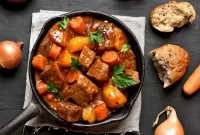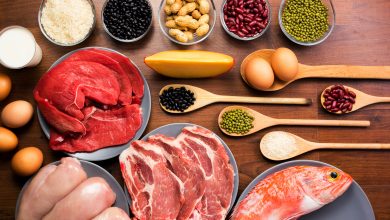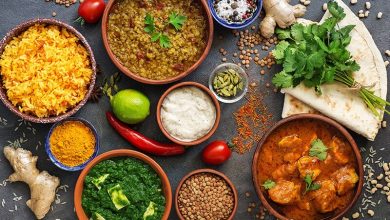Classic: 5 Traditional Serbian Dishes
The young chef of the Subbotitsa restaurant was born into a family of hereditary Serbian chefs: “Everyone works in the kitchen for us – grandfather, father, me, my younger brother.” Minić mastered the art of cooking in the south of Serbia, where the tradition of cooking roshtil (grilled meat) is especially strong. Darko is a student of the famous master of Pirot roshtil Boban Tancic, as part of his team he has repeatedly participated and won at grill festivals.
Rostil and splash
“Meat is the basis of the national Serbian cuisine, it has been elevated to a cult in our country. Rostil is not only the grill itself, on which meat is cooked, but also a meat dish that everyone calls rostil!
Rostil is also a Serbian gastronomic specialty, preserved and passed down from the distant past. The most popular meat dishes on roshtil are splash, chevapchichi, ushtiptsy, hanger, plenitsa, pilecha-dzhigeritsa… They can be ordered individually or assorted.
Every year in the city of Leskovac in southern Serbia, a rostil festival called “Rostiliad” takes place. The whole city these days smells of meat, coals and spices. Every year the world record for the largest splash is updated. It is a large flat cutlet of veal and pork meat, grilled on each side. It is not known who exactly invented the splash, but it has been eaten in the Balkans for hundreds of years.
Many joke that people in Serbia love to eat and a small portion is not enough, which is why the splash is so impressive in size. To cook splash, you need to form a large circle of meat and constantly slap it with your hands, which in Serbian means pljeskati. Hence the name – splash. Splashes are always served with fresh onions.

This schnitzel is named after the Serbian prince Karageorgi, who, by the way, has nothing to do with the dish. The name of the prince was simply the first thing that came to the mind of the cook, who not so long ago came up with this dish, which has already become a classic of Serbian cuisine.
At the end of the fifties of the last century, by chance, finding himself in a hopeless situation, Karađorđe was created by the then very young chef Micha Stojanovic – by the way, the personal chef of Josip Broz Tito. He was supposed to cook Kiev cutlets for a guest from the USSR, but there was no chicken meat and butter on hand.
and Stojanovic made a veal dish stuffed with kaymak (a unique dairy product obtained by skimming thick froths from boiling milk). The schnitzel was drenched in tartar sauce and garnished with a slice of lemon, symbolizing the ribbon and the Order of the Star of Karageorge, which is how the dish got its name. Because of its impressive size and phallic shape, people call it “Girl’s Dream” or “Girl’s Dream” as a joke.
Prebranac
“Beans are a folk food in Serbia, a real cult. We can’t imagine our life without beans just like you Russians can’t imagine without potatoes. There is even a saying: “Just kak pasulj!” (“Just like beans!”).
Prebranac is made from white beans and stewed for a very long time with a lot of fried onions, after which it is baked in the oven. Onion is added very, very much, but in the cooked dish, of course, it is practically not felt. Baked beans are very tender and amazing with an unusually rich taste. Everyone loves Prebranac, it is cooked all year round in Serbian families and served in all restaurants in Serbia.”
Aivar
“Caviar from baked sweet pepper. Any pepper we call paprika. Serbs adore this ingredient, and whatever: sweet, spicy, baked, pickled. It is the use of paprika in cooking that distinguishes Serbian cuisine from other cuisines of the world. In the Balkans, paprika is grilled on all sides, then the skin is removed and the pepper is ground in a meat grinder.
The resulting mixture is fried for three hours, evaporated to a paste-like consistency to make ajvar – a favorite national Serbian dish. This great appetizer is used both on its own and goes well with meat, and just with a piece of freshly baked bread! In our restaurant, we prepare ajvar in large quantities every year.
because the Russians are very fond of this appetizer. In our country, when a guy is going to get married, he is asked: “Have you tried ajvar from this girl? How is he good?” Because every housewife has her own recipe and it is impossible to imagine a Serbian table without ajvar.”
pita
“Flour products are a serious layer of Serbian cuisine. In principle, any pie we have is called a pita. National pies are also made from thin puff pastry with various fillings, which are called: pita, burek, gibanitsa, zelyanitsa.
Even in medieval Balkan bakeries, pita was baked, which looked like a closed pie made from thin dough made from wholemeal flour stuffed with meat and cheese. And during the reign of despot Stefan Lazarevich, it was established by law that mine workers have the right not to pay for a tasteless, unsuccessful pita … Pita is sweet (with apples, prunes, cherries) and salty (with meat, cheese, cheese and spinach).
Chevapcichi
Connoisseurs of juicy sausages and homemade meatballs will be delighted with Serbian cuisine. The locals are very fond of meat. They brilliantly prepare simple, hearty dishes that are impossible to tear yourself away from. Order mixed meat at the restaurant to taste the most popular meat delicacies in Serbia at once.
If you can’t master a serving weighing 1-2 kg yet, start with chevapchichi. These are spicy minced meat sausages with garlic. Order a portion “clean”. Or try Belgrade street food – sausages with crispy onions, juicy herbs and fresh tomatoes. The whole thing is wrapped in crispy pita and topped with a refreshing kaimak sauce. Hearty and soulful!
Karadjordjeva schnitzel
Serbian schnitzel is named after Prince Karageorgi and is not so simple. It is more like a chicken Kiev. However, it is made from pork or veal, not chicken. They say that the creator of the recipe cooked it, but did not find the right meat. The Serbs messed up everything everywhere, but they made such a tasty dish that there is nothing to reproach.



